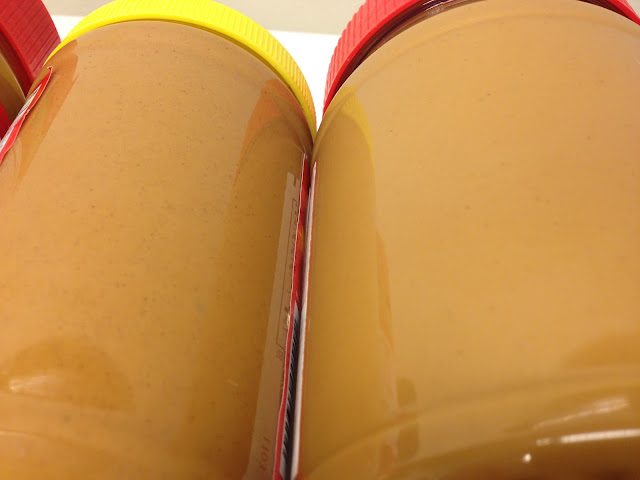Price: The Kraft mac 'n cheese cost a full 80% more than the generic mac 'n cheese. The boxes we tested were different sizes (7.25 oz. vs. 5.5 oz., respectively), but we took that into account before doing our calculations. This huge difference seemed a little crazy to us so we thought we better check it out again at the store. And it turns out (as you can see from the picture above), the Kraft version we tested was the "three cheese" variety, so not an exact comparison to the GV spiral macaroni & Cheese. We're not sure how much of a difference in taste the "three cheese" version made, but there was a difference in price between that version and the Kraft spiral mac 'n cheese, which cost only 56% more than the GV spiral mac 'n cheese. Who knew there were so many different varieties of mac 'n cheese? Kraft alone offered at least four different kinds of just the regular (not "premium" or "homestyle" or any of those) boxed mac 'n cheese. So keep that in mind for what it's worth - there are many different varieties of boxed regular mac 'n cheese, ranging widely in price even within the same brand!
Ingredients: Great Value: enriched macaroni product (durum wheat flour with niacin, iron (ferrous sulfate), thiamin mononitrate, riboflavin, folic acid), whey, enriched bleached flour (bleached wheat flour, niacin, iron, thiamin mononitrate, riboflavin, folic acid), cheddar cheese (milk, cheese culture, salt, enzymes), salt, modified cornstarch, disodium phosphate, calcium carbonate, citric acid, color (yellow 5 and 6).
Kraft: enriched macaroni product (wheat flour, niacin, ferrous sulfate (iron), thiamin mononitrate (vitamin B1), riboflavin (vitamin B2), folic acid), cheese sauce mix (whey, milk, salt, skim milk, milkfat, milk protein concentrate, modified food starch, contains less than 2% of sodium tripolyphosphate, buttermilk solids, sodium phosphate, citric acid, cellulose gel, cellulose gum, lactic acid, cheese culture, calcium phosphate, yellow 5, yellow 6, enzymes).
There's one interesting thing we have to point out here - the Kraft mac 'n cheese does not list "cheese" as an ingredient in its cheese sauce mix, while the generic does - or at least attempts to, by mentioning "cheese culture" as an ingredient... so Kraft mac 'n cheese doesn't have actual cheese in it?? Not that we really thought it did, to be honest - when you dump that pinkish-orange powder into the pasta "cheese" is not the first thing that comes to mind...
Calories/Nutritional Information: The calorie/nutritional information for mac 'n cheese varies widely depending on what you mix with it (skim milk? whole milk? butter? margarine?) so we're comparing the nutritional information provided for the mac 'n cheese before the milk and butter is added.
Both the Kraft and Great Value mac 'n cheeses contained the same amount of calories per serving (250 - again, that's without the butter and milk - if we have any calorie counters out there, don't think that's all you're getting when you actually eat it!) 5 grams of cholesterol, 49 grams of carbohydrates and 9 grams of protein. Kraft contained 2 grams of fat per serving, vs. 1.5 for Great Value, and had 610 mg of sodium per serving, vs. 570 mg for Great Value. Great Value also lists potassium content (which it seems to do in the nutritional information for all of its products, while few, if any, other brands do) at 210 mg per serving. Both versions also contain 10% of your RDV for calcium and iron, and GV also lists 30% of your RDV for folic acid.
 |
| GV on the left - we took this picture in natural light so you can really see the difference! |
Regardless of being labeled as "three cheese," we think the difference in moistness/ creaminess may just have to do with the preparation instructions. We prepared both of these according to their directions on the box, and the GV mac 'n cheese said to mix 1 teaspoon of unsalted butter and 3 tablespoons of milk in along with the sauce powder. The Kraft mac 'n cheese, on the other hand, said to add 4 tablespoons (that's TABLESPOONS, not TEASPOONS) of margarine (we used unsalted butter for both, to try to keep the results similar) and 1/4 cup of 2% milk (we used 1% milk in both). So isn't it obvious why the Kraft mac 'n cheese is creamier and the generic is drier? The Kraft mac 'n cheese has over 4 times as much butter and milk in it! Now, we're not sure how the GV mac 'n cheese would turn out if we put the same amounts of milk and butter in both, because we wanted to follow the directions, but we suspect it would make a difference... if anyone tries that let us know how it goes!
Texture/the chew test: As we mentioned above, the GV mac 'n cheese ended up a lot drier, while the Kraft was more creamy, gooey and moist.
Taste: The Kraft mac 'n cheese had a more buttery (obviously the extra butter makes a difference) and salty flavor than the GV mac 'n cheese. The GV mac 'n cheese was just blander and had less flavor overall, despite actually listing "cheese" in its ingredients. Neither of these tasted particularly cheesy.
Bottom line: we're willing to try the GV mac 'n cheese again given the great cost savings, but we plan on adding more butter and milk the next time we make it in the hopes of replicating Kraft's creamy moist cheesy consistency (in addition to adding some flavor). If that doesn't work, though, we'll pay extra for that creamy cheesiness that reminded us of our childhood!





























